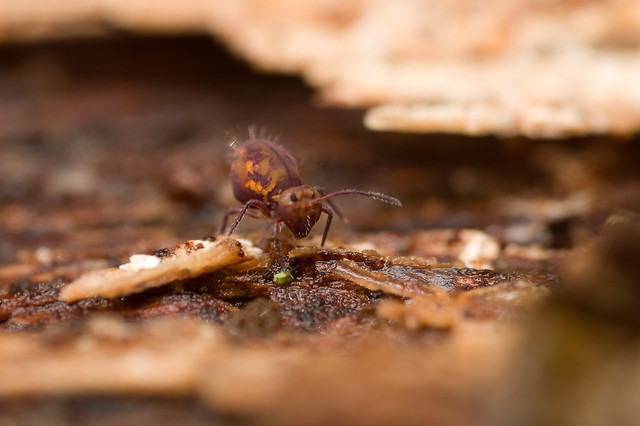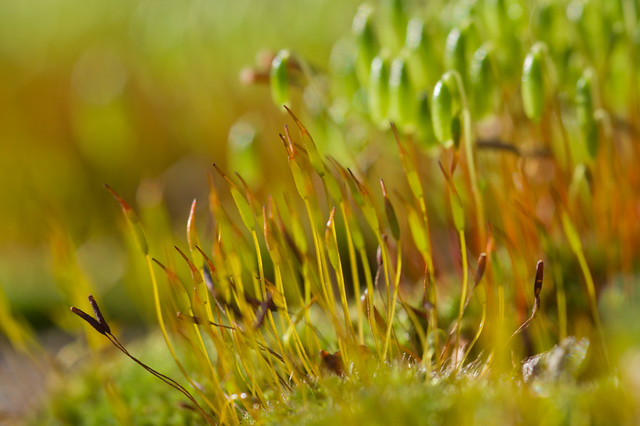It was a gloriously sunny day yesterday, so the obvious thing to do was to head down to the woods (
with a fully charged set of batteries!) to see what I could find lurking in the leaf litter. Before I set off I had a quick look around the garden to see if any of the various weeds I've been cultivating have got to the stage of being identifiable, and noticed one of my carpet of Hairy Bittercress had opened its tiny white flowers to the spring sunshine.
 |
| Hairy Bittercress |
I then decided to see how the bee hotel had fared in the recent wind and rain. Fortunately all of the residents seem safely still in place, and had been joined by a temporary resident in the shape of a seven-spot ladybird.
 |
| Sleepy Seven-spot |
I then headed out onto the bridleway, and was soon wondering how I'd previously managed not to notice the blackthorn tree which was growing within 50 metres of the house. Mind you, it was a bit more obvious now that it was covered in beautiful white blossoms!
 |
| The subtle and easy to miss Blackthorn |
Further along the path I stepped to one side to let some horses past, and in the process spotted a rather non-descript looking plant growing at the side of a field of cauliflowers. It looked a bit like a humped daisy that had lost all its petals, but it turns out that the flowers of pineapple weed never have any. I'm definitely going to go back and give it a sniff to see if it really smells like pineapple though!
 |
| Pineapple Weed |
I continued along to the edge of the quarry, stopping periodically to check the fence posts which have turned up a variety of species in the past. Today was no different, with a multitude of springtails clustered on almost every post. Most of them looked like the
Entomobrya I'd previously found in my garden, but on one post there were a couple of smaller, blackish looking ones, which on closer inspection proved to have a beautiful iridescent coat clothed in a blanket of short hairs. After a trawl of the usual locations (naturespot and http://www.collembola.org/key/fkuk.htm are both excellent) I'm fairly confident that these were
Vertagopus arboreus.
 |
| The tiny but beautiful Vertagopus arboreus |
It wasn't only springtails chilling out on the posts, there were also a number of tiny spiders which I decided to leave for another day, and a very early instar nymph of the common shieldbug
Pentatoma rufipes - or Forest Bug to their friends.
 |
| Early instar Forest Bug |
I then headed away from the quarry and into a patch of mixed Scot's Pine and Oak forest which I'd previously earmarked as a promising site. Before I'd even started fishing around under bits of bark I noticed a large fungus growing on a dried out piece of wood which thanks to the helpful folk at Ispot I'm able to say is the common Jelly Ear or Jew's Ear. I also dimly remembered seeing on the 1000for1ksq blog that there was a fungus which grew on bracken stems, so I had a quick look around. Sure enough the first stem I looked at had a series of black markings on it and after tracking down the original post I'm fairly sure that they are the same thing - Bracken Map.
 |
| Jelly Ear |
 |
| Bracken Map |
Finally I got around to flipping over some bits of bark, sending clouds of springtails flicking into the air and woodlice scuttling for cover. In amongst all of these, one creature stood out, a yellow springtail with huge antennae easily as long as its body. He wasn't too keen on being exposed to daylight, and started rushing for cover, but I was able to get a couple of shots before he disappeared into the leaf litter. After looking on the websites named earlier it seems pretty clear that this is one of the
Pogonognathellus species, but I'm not currently sure which. Hopefully someone helpful will give me a hand! in adddition to this monster of the springtail world (fully 6mm long!) (edit someone helpful has indeed identified my springtail as
P.longicornis) there were some more typically sized globular springtails. In addition to the
Dicyrtomina saundersi I've previously found there were some smaller darked ones which I think are
Dicyrtoma fusca.
 |
| Pogonognathellus longicornis |
 |
| Dicyrtoma fusca |
I decided to switch to the 300mm for the walk home, and as I was switching over a nuthatch conveniently landed in the tree above me and started prospecting for nest sites. It was a bit high up to get any particularly good photos, but I'll take the reoord shots for now!
 |
| Nuthatch looking for a new home |
Total: 85 Species - see all the photos here
Lifelist 1288 Species - new additions Pineapple weed,
Vertagopus arboreus, Jelly Ear, Bracken Map,
Pogonognathellus longicornis,
Dicyrtoma fusca and, slightly embarrassingly, Blackthorn!



























